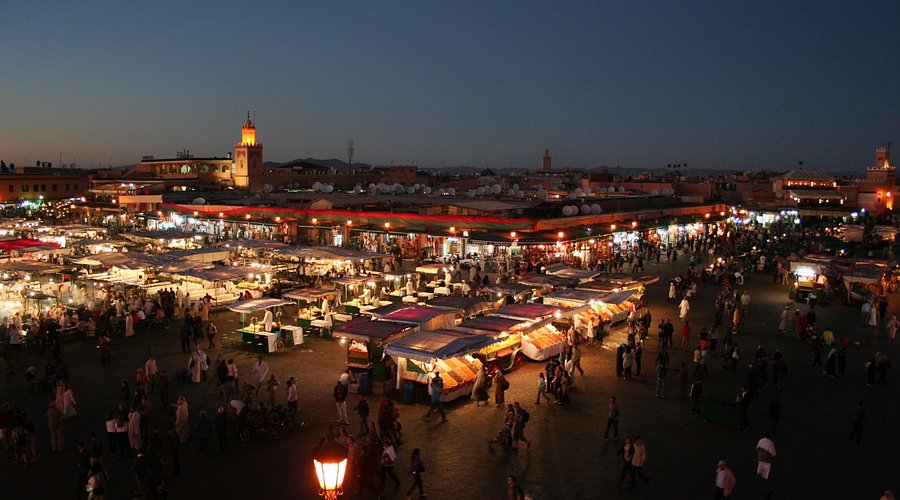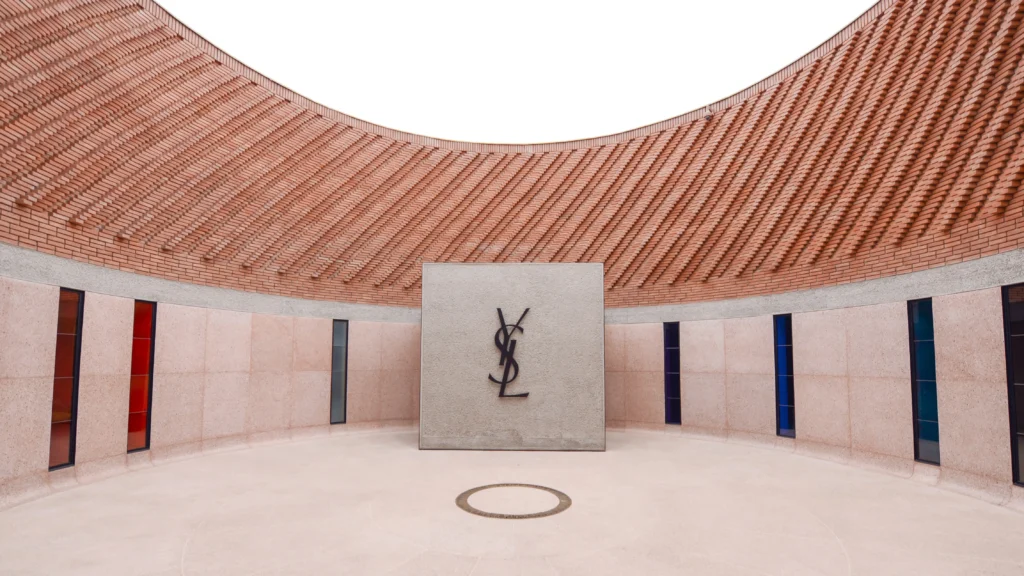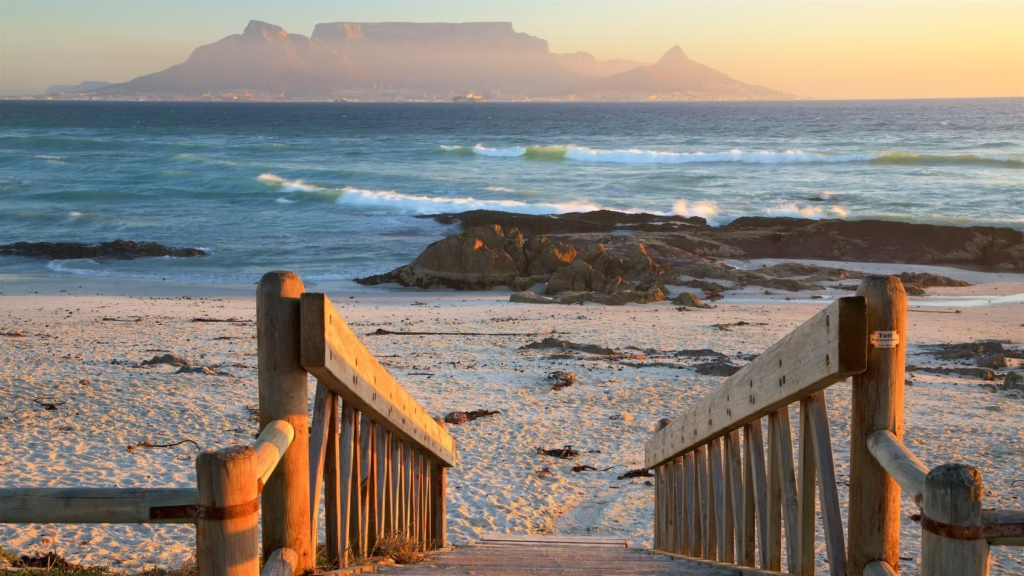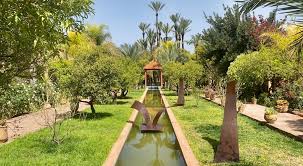Prepare for your senses to be slapped – Marrakesh is a whirlwind of colour, noise, and life that will dazzle, frazzle, and utterly enchant. From the hypnotic rhythms of the Jemaa el-Fna square to the intricate patterns of tiled riads, the city pulses with energy. Aromas of sizzling street food mix with the scent of rose water and spices in the souks, while the call to prayer echoes off ochre walls. Slip on your babouches and dive headfirst into the medina’s maze – in Marrakesh, every corner holds a surprise.

Jardin Majorelle is a captivating blend of botanical wonder, cultural heritage, and artistic legacy that continues to inspire visitors from around the world. Nestled in Marrakesh’s Ville Nouvelle district, this enchanting garden was originally created in 1924 by French painter Jacques Majorelle, whose love for plants and Morocco’s vibrant aesthetics gave birth to its famed cobalt “Majorelle Blue” accents.
Saved from neglect in 1980 by fashion icon Yves Saint Laurent and his partner Pierre Bergé, the gardens have since become Morocco’s most visited tourist attraction, welcoming nearly a million visitors annually. The 10-acre estate is home to more than 300 species of flora from five continents, and every turn through its shaded bamboo groves and exotic cactus beds feels like stepping into a living painting.
At the heart of the garden stands Majorelle’s electric-blue art deco studio, now transformed into the Musée Berbère, celebrating the rich culture and artistry of Morocco’s indigenous Berber people through a dazzling collection of over 600 objects — from traditional attire to exquisite jewelry.
To accommodate the rising number of visitors, the Villa Oasis Gardens — once the private home of Saint Laurent and Bergé — opened in 2018, unveiling an even more opulent side of the estate, complete with koi ponds, ornate pavilions, and lush Mediterranean landscaping. While the villa interior remains off-limits, its magical exterior and gardens leave a lasting impression.
Visitors can also enjoy Café Majorelle, a charming spot within the grounds perfect for a quiet refreshment, or browse the stylish boutique offering unique souvenirs like Majorelle blue slippers and Amazigh-inspired jewelry.
Practical tips:
Arrive before 10am, or ideally at opening (8am), to avoid long lines.
Buy tickets online for quicker access, and consider visiting Friday to Monday for access to the Villa Oasis gardens.
Don’t skip the Musée Berbère – it’s well worth the additional fee.
For the best light for photography, aim for an afternoon visit.
A combined ticket with the nearby Musée Yves Saint Laurent is available and allows you to fully immerse yourself in the artistic legacy of YSL.
Whether you’re drawn by the botanical beauty, the artistic ambiance, or the fashion legacy, Jardin Majorelle remains a true jewel of Marrakesh — a space that continues to bloom with color, culture, and timeless elegance.

Roll up, roll up for the greatest show on earth!
Welcome to Djemaa El Fna, the main square of Marrakesh where every corner is bursting with colour, culture, and life. From morning snake charmers to late-night music and food, this place has been a centre of excitement since the 11th century.
Djemaa El Fna came to life in the 11th century, around the same time Marrakesh was founded by the Almoravids. There are many stories behind the square’s name. Some say it means “assembly of the dead” or “mosque of the dead” – possibly linked to public executions or the collapse of the nearby Koutoubia Mosque.
Once a busy market for mountain traders, the square has evolved over time. During the French protectorate, the current boundaries were set, and the energy of Djemaa shifted from trade to theatre.
In 2001, UNESCO recognised the square as a Masterpiece of World Heritage, celebrating how it keeps Morocco’s oral traditions and culture alive.
By day, the square is home to snake charmers, henna artists, juice vendors, and even traditional dentists! But the real magic starts after sunset. Musicians tune up, food stalls fire up grills, and performers take their places.
🎵 Gnaoua musicians, Amazigh dancers, and street comedians entertain crowds until midnight. It’s a carnival every evening — and you can be a part of it just by showing up!
However, not everything is cheerful. Monkeys in chains and questionable snake-handling still happen here. It’s better to admire from afar and support ethical practices.
Djemaa El Fna has been protected since 1922, but UNESCO recently raised concerns. Urban changes and tourism are pushing out traditional performers like storytellers (hikayat), and younger generations are turning to modern jobs. While the energy remains, the old ways are slowly disappearing.
Mornings here are calm and peaceful. Orange juice stands open early, followed by potion sellers and snake charmers. It’s a good time to walk around without the crowds.
From 2 pm, no vehicles are allowed in the square. By 4 pm, food stalls start preparing, and by sunset, the whole square turns into a buzzing open-air theatre. If you want the best view, grab a seat at one of the rooftop cafes surrounding the square.
Love street food? You’re in the right place! From snail soup to grilled meats and hot tajines, there’s something for every foodie.
Here are some must-try stalls:
Stall 1 (run by Aicha): Brochettes, tajines, and harira soup
Stall 14: Fried fish and calamari
Snail stalls: Eastern edge of the square
Chez Mohammed (No. 71): Ginger tea and spicy cake
Tip: Eat with bread instead of utensils, wash your hands before eating, and drink only filtered water.
Watch your belongings – Pickpockets can be active, especially after dark.
Arrive early – To get front-row seats for performers.
Bring small coins – A few dirhams for tips is polite, especially if you take photos.
Avoid unethical shows – Say no to animal cruelty.
Budget hotels are found near Rue Sidi Bouloukat and Rue de la Recette, very close to Djemaa. If you prefer something more elegant, check the riads near Rue Riad Zitoun El Jedid.
Want to try tanjia (slow-cooked lamb stew) or mechoui (roasted lamb)? The square and its surroundings are perfect for food lovers.
Try Hadj Mustapha for some of the tastiest tanjia. And if you’re tired, enjoy a cup of mint tea from the Grand Balcon du Café Glacier while people-watching from above.
Located at the edge of the medina, it’s a:
20-minute walk from Bab Doukkala
15-minute walk from Place des Ferblantiers
From central Gueliz, take Bus No. 1 or 16
Djemaa El Fna is not just a place — it’s an experience.
Whether you’re there for the food, the music, the history, or just to soak in the atmosphere, this is one show you’ll never forget.

Opened in 2017, the Musée Yves Saint Laurent in Marrakesh is a tribute to the legendary French designer and his deep connection with Morocco. The museum showcases over 40 years of YSL’s haute couture creations, accessories, sketches, and personal memorabilia.
Designed by Studio KO, the building itself is a masterpiece, inspired by the texture of woven fabric. Its terracotta façade echoes Marrakesh’s iconic red hues, while the smooth, elegant interiors reflect the lining of a couture jacket. Inside, visitors can explore a dramatic black-walled exhibition hall, a circular stained-glass patio inspired by Matisse, and a zellige-tiled courtyard.
Highlights include a rotating display of YSL’s fashion, his early letters and sketches, and a 150-seat auditorium hosting films and performances. A library housing 5,000 books on fashion, botany, and Amazigh culture is available by appointment.
Located next to the famous Jardin Majorelle, the museum offers combined tickets for both sites—best purchased at the museum to skip the queues. Nearby, you’ll find stylish cafes like Le Studio and Pause Gourmande, and accommodation in both the historic medina and the modern Ville Nouvelle.
Tip: Haggle for a taxi or hop on Bus 12 from Bab Doukkala to reach the museum with ease.

Rising elegantly over Marrakesh’s medina, the Koutoubia Mosque has been a beacon of faith since the 12th century. Its 250-foot-high minaret, a masterpiece of Moorish design, is the city’s most iconic silhouette—adorned with scalloped arches, merlon crenelations, and timeless symmetry. It even inspired architectural wonders like the Giralda in Seville and the Hassan Tower in Rabat.
Unlike domed minarets seen in the Middle East, Koutoubia’s square shape reflects Amazigh influence. Inside, there’s no staircase—only a spiraling ramp once used by the muezzin on horseback. Atop the minaret, three gleaming brass spheres (originally gold, according to legend) shimmer thanks to mineral salts from the High Atlas Mountains, refreshed yearly during Ramadan.
The mosque’s name, “Koutoubia,” comes from the Arabic kutubiyyin, meaning booksellers—once over 100 of them set up shop around its base. Today, the adjacent Koutoubia Gardens offer a peaceful haven from the medina’s bustle, with palm-lined paths and picture-perfect views of the minaret.
While non-Muslims can’t enter the mosque, you can admire it from many scenic angles—especially under the arch near the main entrance or over mint tea at Café El Koutoubia. Just steps from Djemaa El Fna, it’s easy to reach on foot, by bus (Route 16), or even via a short cab ride from Gueliz.

Five times a day, the melodic call to prayer rises from the minaret of Koutoubia Mosque, echoing across Djemaa El Fna and beyond. Built in the 12th century by the Almohads, the mosque’s towering minaret remains Marrakesh’s most iconic landmark—a masterpiece of Moorish design adorned with scalloped arches, merlon crenellations, and perfect proportions.
This 250-foot-high minaret became the blueprint for the Giralda in Seville and the Tour Hassan in Rabat. Unlike the domed minarets of the East, Koutoubia’s square design reflects the Amazigh style. Intriguingly, there are no stairs inside—just a ramp once used by the muezzin on horseback to ascend for the call to prayer.
Legends swirl around the golden balls atop the minaret’s spire, said to be crafted from melted gold jewelry offered by the sultan’s wife in penance for breaking her Ramadan fast. Today, they gleam with mineral salt from the High Atlas Mountains, replaced annually during Ramadan to preserve their luster.
The mosque’s very alignment with Mecca was once contested—so much so that its first iteration was torn down mid-construction, a testament to the Almohads’ devotion. You can still see the haunting ruins of the original prayer hall to the northwest, believed to have partially collapsed during the 1755 Lisbon earthquake.
Surrounding the mosque is the tranquil Koutoubia Gardens, dotted with palm trees and beloved by locals for afternoon strolls. The best photo spot? Under the stone archway to the left of the entrance, framing the minaret with date palms and the golden Marrakshi light.
Though non-Muslims aren’t allowed inside, the mosque is easily admired from the outside—and its spiritual presence is impossible to miss. Nearby, budget hotels cluster around Rue Sidi Bouloukat, while mint tea with a view awaits at Café El Koutoubia. Bus 16 from Gueliz drops you right in front of this Marrakesh marvel.
Just south of the Koutoubia Mosque, tucked behind the Kasbah Mosque, lie the Saadian Tombs—a regal resting place that disappeared from memory until French aerial photography rediscovered it in 1917.
Built by the lavish Sultan Ahmed Al Mansour Ed Dahbi in the 16th century, this necropolis is adorned with Carrara marble and honeycomb muqarnas gilded in pure gold. The Chamber of the Twelve Pillars, housing the sultan and his sons, dazzles with Roman marble columns plundered from Volubilis and intricate zellige tilework. The view is only possible through a small arch at present, but a circular viewing platform is in the works.
Adjacent rooms include the Chamber of Three Niches, reserved for princes, and a former prayer room, which later became a burial site for close court members. The mihrab—a five-sided prayer niche—remains a stunning focal point.
Out in the courtyard is the tomb of Al Mansour’s mother, Lalla Massouda, carved with prayers and guarded by cats and the occasional tortoise. This mausoleum predates the rest and was lovingly expanded by the sultan. The original entrance, sealed by the jealous Sultan Moulay Ismail, still stands—silent testimony to dynastic rivalry.
Wander among the Garden Tombs, the final resting place for royal household members and ministers. One, it’s said, belongs to the sultan’s trusted Jewish adviser—its subtle distinction still visible to the keen-eyed.
To avoid the tourist rush, visit early in the morning or in the late afternoon, when golden light washes over the marble and mosaics. The Kasbah district is quieter than the busy northern medina, making it a peaceful base with charming stays and eateries. After your visit, relax across the street at Kasbah Café or savor a camel burger at Café Clock, just down the road.
Access is through an unmarked alley next to the Kasbah Mosque—look for Kasbah Café and take the narrow lane to the entrance of this once-lost kingdom of splendor.

Hidden for centuries behind a wall and rediscovered in 1917, the Saadian Tombs are a majestic resting place of Morocco’s golden era. Sultan Ahmed Al Mansour spared no expense when creating this lavish necropolis in the 16th century. From Italian Carrara marble to golden honeycomb muqarnas (decorative plasterwork), the tombs are a breathtaking tribute to royal luxury.
Chamber of the Twelve Pillars
Admire this main chamber through an arched doorway – a masterpiece of geometric tilework and Roman marble columns, where Sultan Al Mansour and his sons are laid to rest.
Chamber of the Three Niches & Prayer Room
Surrounding chambers house the tombs of princes and nobles, with intricately carved walls and a mihrab that once guided royal prayers.
Lalla Massouda’s Tomb
Set in a quiet courtyard, this tomb was built for the Sultan’s mother. Carved blessings, stray cats, and even tortoises guard this peaceful space.
Garden Tombs
The final resting place of court members, chancellors, and possibly a trusted Jewish adviser – the tombs here are simpler, but still rich in stories.
Best Time to Visit: Early morning or late afternoon for golden light and fewer crowds.
Location Tip: Enter via the narrow alley beside Kasbah Mosque, near Kasbah Café.
Spanning 8000 square metres, Bahia Palace is a wonder of Moroccan architecture and design. From painted wood ceilings to vast marble courtyards, every inch of this palace radiates elegance and history.
Petit Riad
Near the entrance, this charming courtyard feels intimate, but its delicate white plaster carvings and Quranic inscriptions are nothing short of extraordinary.
Cour d’Honneur
The heart of the palace – a 1500 sq metre courtyard of Italian marble, surrounded by bold blue-and-yellow painted galleries. Once a royal harem, now a visual feast.
Grand Riad
The oldest and most peaceful corner of the palace. Lush gardens, colourful stained glass, and hand-carved woodwork bring this 19th-century vision to life.
Historical Note: Built in the 1860s, expanded by Grand Vizier Bou Ahmed to house his wives and concubines, and later used by French officials. After independence, it became a national treasure.
Nearby Eats:
Kasbah Café – Perfect for a break after exploring the tombs.
Cafe Clock – Known for camel burgers and creative Moroccan fusion.
Where to Stay:
Consider the Kasbah district for a quieter stay, away from the hustle of central Marrakesh, yet steps from these stunning sites.

Once the grandest palace in the Muslim West, El Badi Palace is now a hauntingly beautiful ruin — a poetic echo of Marrakesh’s golden age. When Sultan Ahmed Al Mansour began construction in 1578, he spared no expense: the palace was decked with gold, turquoise, Italian marble, and crystal. Yet, as legend has it, even his court jester predicted, “It’ll make a beautiful ruin.”
Sultan Al Mansour commissioned El Badi to celebrate his triumph in the Battle of the Three Kings. Known as “the Golden King”, his reign marked the high point of the Saadian dynasty. Inspired by the luxurious palaces of Moorish Andalusia, El Badi once dazzled guests with 360 richly decorated rooms, sunken gardens, and shimmering pools.
But the splendor didn’t last long. In the early 1700s, Sultan Moulay Ismail dismantled the palace stone by stone to build his own capital in Meknes. What remains today is a majestic skeleton—walls, underground chambers, stork nests, and sweeping panoramic views from the ramparts.
Vast Courtyard & Gardens
Picture the past as you walk across the enormous central courtyard. The four sunken gardens and long reflecting pools hint at the palace’s once-opulent design.
CGI Reconstruction Film
In a room along the eastern wall, a short CGI video brings El Badi’s former glory to life, offering a rare visual reconstruction of what once stood.
Underground Chambers
Explore the cool subterranean rooms beneath the palace – once thought to house prisoners or slaves. Today, two modest exhibitions share the history of Marrakesh’s Kasbah and Mellah districts, as well as life in these shadowy quarters.
Khayzuran Pavilion
This structure across the courtyard often hosts rotating contemporary art exhibits, bridging past and present.
The Koutoubia Minbar Room
A true hidden gem: this 12th-century prayer pulpit, crafted in Cordoba, is made of cedarwood inlaid with gold and silver calligraphy. It’s one of the finest surviving pieces of Islamic woodwork and was painstakingly restored by the Metropolitan Museum of Art.
Don’t miss: The storks nesting on the palace walls – a symbol of longevity and protection in Moroccan culture.
Getting there: Walk through Place des Ferblantiers, then turn right along the ramparts to reach the entrance.
Best photo spot: The upper ramparts offer stunning panoramic views of Marrakesh’s rooftops and the Atlas Mountains beyond.

Tucked away in the tranquil Palmeraie district, far from the bustle of central Marrakesh, the Musée de la Palmeraie is one of the city’s best-kept secrets. Set within a serene Andalusian garden scattered with traditional adobe houses, this private museum offers a refreshing and intimate dive into Morocco’s modern art scene.
Unlike the medina’s tourist-tilted art stalls, the Musée de la Palmeraie is authentic, thoughtful, and refreshingly uncrowded. Inside, you’ll find a superb curation of 20th- and 21st-century works — from vibrant watercolours and prints to bold sculptures and photography.
The museum showcases the creative journeys of Marrakesh-born talents like Hicham Benohoud, Abderrahim Iqbi, and Larbi Cherkaoui, whose works explore Moroccan daily life, tradition, and Islamic influence through a modern lens.
Quiet Escape
A peaceful setting that feels miles away from the medina — a true art sanctuary.
Genuine Creativity
Art that reflects the real Morocco, not the postcard clichés.
Garden Walks
Wander through beautifully landscaped gardens between exhibition halls, perfect for reflective pauses.
WhatsApp us